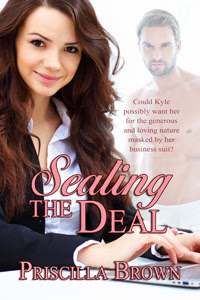Mayor Anna's town and her farm are struggling.
Is this sexy television entrepreneur financial salvation or major trouble?
Find details of this and my other contemporary romances on
and visit Priscilla Brown at your favourite e-book store
Inhabits all those houses in my head, that is. In my real life, I have just one house, a small house in a small town in New South Wales: the design and appearance of this dwelling, nor any that I have ever lived in, do not appear in any of my novels. Where do I get the ideas for my characters' homes?

In my stories, the only house that owes its presence partly to an existing building is Anna's farmhouse in
Sealing The Deal. Some years ago I used to visit this homestead, and my writer's mind stored its appearance, its timber construction and wraparound veranda for possible inclusion in fiction one day.
Other than this, I am not writing about houses I've met. I glean impressions from various sources, including observations while visiting other areas, travelling, magazines, and some of these fragments gel into composite yet incomplete images for my characters to call home. Such snippets are merely a small part of the final pictures in my head. Imagination personalises the dwelling, ascertaining the size, appearance and location, adding details. Occasionally the character may have a suitable finished place to live when I begin a story's first draft, but usually this evolves as the plot develops. My aim is to create the home, outside and inside, appropriate to the personality and lifestyle of its inhabitant; it should also promote an atmosphere in which the storyline can flourish.
Each of my stories has a notebook, and among pages of scribble I sketch a rough floor plan of the plot's most important house, not attempting to design it anywhere near to scale. I do this to anchor some ideas for the story, perhaps since I don't devise a plot plan, rather let the narrative carry on. In most cases, the original layout needs adjusting to accommodate not only proceeding scenes but the workability of the whole floor. The sketch for Cassandra's cottage in
Silver Linings had the bathroom squeezed into a corner with no place for a door, and much too small for the spa crucial for a significant scene; as a result, the kitchen got moved and reduced. (No significant scenes there and not much cooking either.)
When furniture and other objects are necessarily mentioned, their placement and style may or may not be detailed depending on how important these are to a scene; readers may arrange them how they wish. Furniture can suggest a facet of the occupant's taste and lifestyle: colourful or drab, tidy or untidy, overcrowded or short of seats.

The view from the windows may be critical to the storyline as in the ocean panorama from the Caribbean island cottage belonging to Cameron in
Where The Heart Is; Cristina must leave the man and the view, but is finding it hard to say goodbye. In
Silver Linings, windows are useful to indicate the weather, if it's suitable to go beachcombing on the blustery Southern Ocean beach (or if spending the day in the spa is preferable).
Physical surroundings are important contributors to a home's overall ambience, and to the 'feel' of a story. Is the dwelling rural or urban, isolated or on a busy street, and how does this particular location affect the character both emotionally and practically? Is there a garden? If so, is it looked after? Anna's caring nature tends to her roses in
Sealing the Deal; Cristina's mature Australian garden of flowers and fruit trees contrasts with Cameron's tangle of tropical vegetation.
While the settings of my novels are clear and complete in my head. I try not to over-describe, to allow readers to use their imaginations, thus perhaps feeling they themselves are inhabiting the story.
May 2019 be kind to you. Best wishes, Priscilla
http://bwlpublishing.ca
https://priscillabrownauthor.com
 To begin the great marmalade undertaking, I learnt I had to cut the fruit up, tie the pips and pith in a scrap of muslin thoughtfully supplied by my friend, luckily as the only muslin in my house is a smart dress, and place everything in water to soak overnight.Relax, this job was easy! My overnight relaxation included a dream of sailing on a sea of marmalade in a lemon-shaped boat which hit a large pip and sank. Next morning, my concoction had to simmer for about one and a half hours, after which I took out the bag of pips and added the sugar. Boil rapidly, the recipe instructed. No trouble about that, the brew was rising at an alarming rate. According to the recipe, setting would take between three and fifteen minutes.
To begin the great marmalade undertaking, I learnt I had to cut the fruit up, tie the pips and pith in a scrap of muslin thoughtfully supplied by my friend, luckily as the only muslin in my house is a smart dress, and place everything in water to soak overnight.Relax, this job was easy! My overnight relaxation included a dream of sailing on a sea of marmalade in a lemon-shaped boat which hit a large pip and sank. Next morning, my concoction had to simmer for about one and a half hours, after which I took out the bag of pips and added the sugar. Boil rapidly, the recipe instructed. No trouble about that, the brew was rising at an alarming rate. According to the recipe, setting would take between three and fifteen minutes.



















